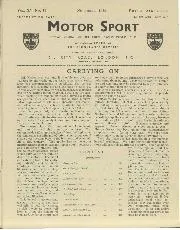
CONTENTS, November 1939
CONT ENTS New Racing Alta An. Irish Hill Climb .,. Rumblings Looking Back ... • •• Continental Notes and News Carrying On ... Home Front, The ••• Driving the Edwardians…
SOME DETAILS OF THE NEW DUESENBURG, FOR WHICH A PHENOMENAL PERFORMANCE IS CLAIMED THE average American motorist up to a short time ago was not particularly interested in the sports
car, and, the fact that the larger ones went quickly is mostly due to the fact that they were fitted with big engines and optimistic speedometers. The Duesenburg Corporation is one of the few companies manufacturing high grade hand made cars, and the supercharged car which was seen in Europe for the first time at the Paris Salon should strengthen the company’s reputation for producing something ahead of the other firms.
The engine is similar to that used in the ordinary model J. chassis, with certain parts strengthened to withstand the extra power. The eight cylinders each with a bore and stroke of 85 and 121 mm. have a total capacity of 6.6 litre, and the engine is stated to give 320 h.p. at 4,200 r.p.m. Four overhead valves per cylinder are used and are operated direct by two overhead camshafts. The camshafts are chain driven and valve clearance is adjusted by inserting shims. Double valve-springs, altnninium pistons, and alloy connecting rods drilled to lubricate the gudgeon pins bring the motor into line with European practise. The centrifugal supercharger is carried above the camshaft covers, and runs at six times engine speed. The drive is taken by skew gear from the off-side accessory shaft,
and the vertical shaft is carried in ball races top and bottom.
The great advantage of the centrifugal blower is its simplicity, and the rotor is merely a dished plate, 12 inches in diameter, with curved vanes. The intake is at the centre, and the compressed mixture is carried away from the outside by an annular passage which is connected to the inlet manifold. A normal Schebler carburretor is fitted, and the blower exerts 8 lbs. pressure at 4,000 r.p.m.
No trouble is experienced from overheating of the mixture, and it has actually been found desirable to warm the blower casing and the induction pipe with water jackets. The induction pipe is a simple fourbranch pipe jacketted in the centre. The chassis lay-out has some interesting features. A two-plate dry-plate clutch precedes a three
speed gear-box with silent second gear all carried in ball and roller bearings, while the semi-elliptic rear springs are relieved of driving strains by a torque tube attached to a cross member at its front end. The final drive is by hypoid pinion and bevel.
Hydraulic brakes are fitted, and the brake drums measure 15 inches in diameter and are three inches wide. The chassis is dropped front and rear and is 8f inches deep in the centre. A chassis lubrication system operated by the
engine supplies oil to all chassis points.
Speeds of 129 m.p.h. and 104 m.p.h. on top and second are claimed with an open four-seater body, while the car is said to reach 100 m.p.h. from a standing start in 20 seconds. These figures are probably rather optimistic, as the Type 55 Bugatti takes 42 seconds from 10 m.p.h., while Gardiner’s Grand Prix Delage requires 18 seconds from a standing start. We hope to be able to publish a short test later in the year. The price of this remarkable car in chassis form is about 23,500 at the factory and the agents in this country are :—Sinclair Motor Concessions, Ltd„ Oxford Road, Chiswick, London, W.4.